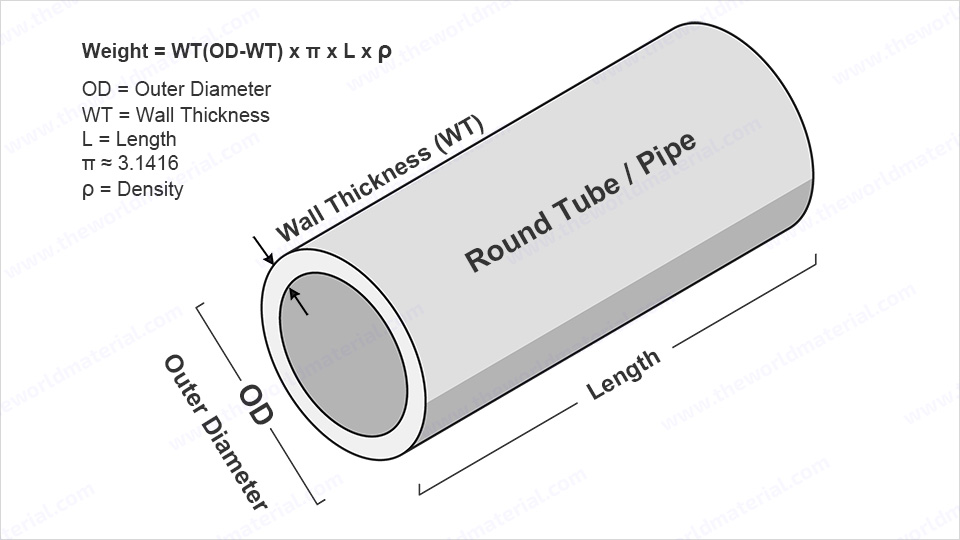Calculating the weight of a metal object is a straightforward process, and it typically involves multiplying the volume of the metal by its density. Here are the general steps to calculate the metal weight:
1. Determine the Shape of the Metal Object:
Identify the shape of the metal object you want to calculate the weight for. Common shapes include rectangular bars, cylinders, spheres, and plates.
2. Measure the Dimensions:
Measure the relevant dimensions of the metal object. The specific dimensions will depend on the shape:
– For a rectangular bar or plate, you’ll need the length, width, and thickness.
– For a cylindrical object, like a tube or rod, you’ll need the outer diameter and length.
– For a spherical object, you’ll need the radius.
3. Calculate the Volume:
Use the appropriate formula to calculate the volume of the metal object based on its shape:
– For a rectangular bar or plate: Volume (V) = Length (L) × Width (W) × Thickness (T)
– For a cylindrical object: Volume (V) = π × (Radius (R)²) × Length (L)
– For a spherical object: Volume (V) = (4/3) × π × (Radius (R)³)
4. Find the Density:
Determine the density (ρ) of the specific metal you are working with. The density of various metals can be found in reference materials or online databases. The units of density are typically grams per cubic centimeter (g/cm³) or kilograms per cubic meter (kg/m³).
5. Calculate the Metal Weight:
Use the formula: Metal weight = Volume (V) × Density (ρ).
 | Metal Plate Weight Calculator Formula Weight = Volume (V) × Density (ρ), Sectional Area (S) = Width (W) x Thickness (T), Plate/Sheet Volume = Length (L) × Width (W) × Thickness (T), so
Metal plate weight = L × W × T × ρ |
| Round Bar Weight Calculation Formula Round bar volume = Cross-sectional area × Length, Cross-sectional area = πr², (“r” = Radius, “d” = Diameter, so r=d/2), so Volume = π(d/2)² ×L = (πd²)/4 ×L, so
Round Bar Weight = (πd²)/4×L×ρ |
| Hexagonal Bar Weight Cross-sectional area = √3÷2 × W²,
Volume = √3÷2 × W² × L,
Hexagonal Bar Weight = √3÷2×W² ×L×ρ |
| Metal Tube / Pipe Weight Formula Round Tube/Pipe Volume = Total volume – Hollow volume, Total volume = π(OD/2)² × L, Hollow volume = π[(OD-WT)/2]² × L, Tube/Pipe Volume = π(OD/2)²×L-π[(OD-WT)/2]²×L, so
Metal tube/pipe weight calculator = WT(OD-WT)×π×L×ρ |
| Rectangular Tube Weight Formula Rectangular Tube Volume = Total volume – Hollow volume = L×W×H – L×(W-2t)×(H-2t), Rectangular Pipe Volume = 2Lt(W+H-2t), so
Rectangular Tube Weight Calculator = 2LT(W+H-2t)×ρ |
| Angle Bar Weight Formula Cross-sectional area (S) = Transverse area + Longitudinal area, Transverse area = Width × Thickness, Longitudinal area = (Height-Thickenss)×Thickenss, Volume = [Wt+(H-t)t]×L = t(W+H-t)×L, so
Angle Bar Weight = t(W+H-t)×L×ρ |
| T-beam / T-bar Weight Formula Sectional area (S) = Flange area + Web area, Flange area = Width × Flange thickness (t), Web area = (Height – t) × Web thickness (i), S = Wt + (H – t) × i, Volume = (Wt+Hi-ti) × L, so
T-beam / T-bar Weight = (Wt+Hi-ti)×L×ρ |
| Steel Beam Weight Formula Top flange area = Bottom flange area, Sectional area (S) = 2×(Flange area) + Web area, Flange area = Width (W) × Flange thickness (t), Web area = Height (H) – 2 × t, S = [2Wt+(H -2t)×i], so
Steel Beam Weight Calculator = (2Wt+Hi-2ti)×L×ρ |
| U/C Channel Weight Formula Total flange area = 2 × (H-i) × t, Web area = W × i, Volume = (Wi + 2tH – 2Ti)×L, so
U/C Channel Weight Calculator Formula = (Wi+2tH-2ti)×L×ρ |
6. Convert Units (if necessary):
Make sure that the units of volume and density are compatible. For example, if you measured the dimensions in centimeters and the density is in g/cm³, your result will be in grams. If you want the weight in kilograms, divide by 1,000 (since 1 kg = 1,000 g).
7. Obtain the Metal Weight:
The result of your calculation will give you the weight of the metal object in the desired units (e.g., grams, kilograms, pounds, etc.).
Keep in mind that this is a general method for calculating metal weight, and it can be applied to a wide range of metal shapes. Precise measurements and accurate density values are essential for obtaining an accurate weight calculation. Additionally, online metal weight calculators are available to simplify this process for common shapes and materials.
Metal Plate Weight Calculator Formula
Weight = Volume (V) × Density (ρ),
Sectional Area (S) = Width (W) x Thickness (T),
Plate/Sheet Volume = Length (L) × Width (W) × Thickness (T), so
Metal plate weight = L × W × T × ρ
Source of part of the article: https://www.theworldmaterial.com/metal-weight-calculator/









